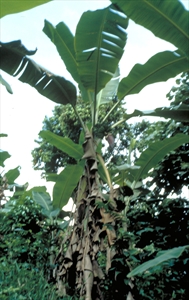Banana wilt, Erwinia wilt. There does not seem to be any accepted common name for this disease. Bacterial heart rot (of banana) is also thought to be caused by Erwinia species.
Pacific Pests, Pathogens and Weeds - Online edition
Pacific Pests, Pathogens & Weeds
Banana bacterial (Erwinia) wilt (214)
Erwinia carotovora ssp. carotovora (now renamed Pectobacterium carotovorum subsp. carotovorum), possibly in association with Erwinia crysanthemi.
Note, Pectobacterium carotovorum subsp. carotovorum causes a basal stalk rot of Chinese cabbage (see Fact Sheet no. 101).
Unclear. The two Erwinia species found associated with the wilt occur worldwide, but the disease is not widely reported. In Oceania, the disease is reported from Australia, the Federated States of Micronesia, Palau and Marshall Islands.
Banana; the two species of bacteria (i.e., Erwinia carotovora ssp. carotovora and Erwinia crysanthemi) infect many other plants, crops and ornamentals (including carnations, chrysanthemums, Dahlia), maize, taro and other aroids, and potato.
Banana wilt occurs on mature plants before the fruit has ripened (Photo1). Leaves of mature plants wilt and die. The leaves hang around the stem like a skirt (Photo 2). Internally, there is a rot of the pseudostem (Photo 3), sometimes accompanied by a foul smell.
Rhizome rot, is also caused by Erwinia carotovora ssp. carotovora and Erwinia chrysanthemi. In this case, newly planted suckers are affected, leading to rotting and a characteristic foul smell. In older plants, rotting occurs at the collar, the part between the base of the pseudostem and soil, and this can lead to plants falling over after snapping at the base. Rots are seen in the rhizomes, and sometimes cavities occur with dark margins.
The bacteria are common in the soil. Spread of banana wilt between plants probably occurs when bacteria are splashed from the soil into the 'throat' or funnel made by the leaves, perhaps when the plants are still young. It is thought likely that the disease occurs when water collects in the "throat" of the banana. Infections of the pseudostems probably occur via wounds.
Spread of rhizome rot probably occurs during the preparation of the corms for planting, when they are trimmed. It may also occur when suckers are removed. The latter is a possibility as the disease is more severe on the first ratoon crop.
Banana wilt and rhizome rot are minor diseases caused by a bacteria belonging to a genus known for its ability to cause soft rots on a wide range of plants. It is unlikely that this disease is of economic importance because it is so seldom seen.
Look for plants that have immature fruit, but have stopped producing leaves. Look for plants where the older leaves have wilted and hang down around the stem. Look for plants that have fallen over in the wind, or bent over because of rots near the base of the pseudostem. Look for foul-smelling rots in the corm. (Note that root infection by nematodes can also cause plants to fall over, or 'topple' as it is called (see Fact sheets nos. 08 and 257).
CULTURAL CONTROL
Before planting:
- Plant disease-free sets; collect planting material only from healthy stools.
- Disinfect knives and other tools after removing suckers from each plant by wiping with bleach.
- Make sure organic matter is well decayed. In Australia, rhizome rot has occurred where bananas have been planted into areas with undecomposed organic matter.
During growth:
- If plants are seen with either banana wilt or rhizome rot symptoms, remove the plants as soon as possible and burn them. The suckers can be left as these may be healthy, but monitor them for infection.
- Avoid water stress. Plants are more susceptible to rhizome rots when water-stressed in hot and dry conditions followed by heavy rainfall.
- Improve drainage in plantations where water collects after rain.
CHEMICAL CONTROL
This not a method to use for the control of this disease.
AUTHOR Grahame Jackson
Information from Diseases of fruit crops in Australia (2009). Editors, Tony Cooke, et al. CSIRO Publishing. Photos 1&2 Kohler F, et al. (1997) Diseases of cultivated crops in Pacific Island countries. South Pacific Commission. Pirie Printers Pty Limited, Canberra, Australia. Photo 3 Department of Agriculture and Fisheries, Queensland, Australia.
Produced with support from the Australian Centre for International Agricultural Research under project PC/2010/090: Strengthening integrated crop management research in the Pacific Islands in support of sustainable intensification of high-value crop production, implemented by the University of Queensland and the Secretariat of the Pacific Community.






